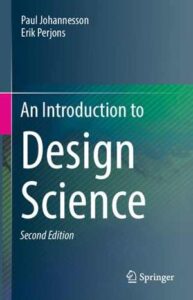نام کتاب: An Introduction To Design Science
نویسنده: Paul Johannesson و Erik Perjons
ویرایش: ۲
سال انتشار: ۲۰۲۱
کد ISBN کتاب: ۳۰۳۰۷۸۱۳۱۳, ۹۷۸۳۰۳۰۷۸۱۳۱۶,
فرمت: PDF
تعداد صفحه: ۲۲۵
حجم کتاب: ۴ مگابایت
کیفیت کتاب: OCR
انتشارات: Springer
Description About Book An Introduction To Design Science From Amazon
This book is an introductory text on design science, intended to support both graduate students and researchers in structuring, undertaking and presenting design science work. It builds on established design science methods as well as recent work on presenting design science studies and ethical principles for design science, and also offers novel instruments for visualizing the results, both in the form of process diagrams and through a canvas format. While the book does not presume any prior knowledge of design science, it provides readers with a thorough understanding of the subject and enables them to delve into much deeper detail, thanks to extensive sections on further reading.
Design science in information systems and technology aims to create novel artifacts in the form of models, methods, and systems that support people in developing, using and maintaining IT solutions. This work focuses on design science as applied to information systems and technology, but it also includes examples from, and perspectives of, other fields of human practice.
Chapter 1 provides an overview of design science and outlines its ties with empirical research. Chapter 2 discusses the various types and forms of knowledge that can be used and produced by design science research, while Chapter 3 presents a brief overview of common empirical research strategies and methods. Chapter 4 introduces a methodological framework for supporting researchers in doing design science research as well as in presenting their results. This framework includes five core activities, which are described in detail in Chapters 5 to 9. Chapter 10 discusses how to communicate design science results, while Chapter 11 compares the proposed methodological framework with methods for systems development and shows how they can be combined. Chapter 12 discusses how design science relates to research paradigms, in particular to positivism and interpretivism, and Chapter 13 discusses ethical issues and principles for design science research. The new Chapter 14 showcases a study on digital health consultations and illustrates the whole process in one comprehensive example. Also added to this 2nd edition are a number of sections on practical guidelines for carrying out basic design science tasks, a discussion on design thinking and its relationship to design science, and the description of artefact classifications. Eventually, both the references in each chapter and the companion web site were updated to reflect recent findings.
درباره کتاب An Introduction To Design Science ترجمه شده از گوگل
این کتاب یک متن مقدماتی در زمینه علوم طراحی است که برای حمایت از دانشجویان تحصیلات تکمیلی و محققان در ساختاردهی ، انجام و ارائه کارهای طراحی طراحی در نظر گرفته شده است. این روش بر اساس روشهای ثابت طراحی علم و همچنین کارهای اخیر در زمینه ارائه مطالعات علم طراحی و اصول اخلاقی برای علم طراحی است ، و همچنین ابزارهای جدیدی را برای تجسم نتایج ، هم در قالب نمودارهای فرآیند و هم در قالب بوم ، ارائه می دهد. در حالی که این کتاب هیچ گونه دانش قبلی از علم طراحی را فرض نمی کند ، اما درک کاملی از موضوع را در اختیار خوانندگان قرار می دهد و آنها را قادر می سازد تا به لطف بخشهای وسیع مطالعه بیشتر ، جزئیات بسیار عمیق تری را بررسی کنند.
علم طراحی در سیستم ها و فناوری اطلاعات با هدف ایجاد آثار بدیع در قالب مدل ها ، روش ها و سیستم هایی است که از مردم در توسعه ، استفاده و نگهداری راه حل های فناوری اطلاعات پشتیبانی می کند. این کار بر علم طراحی متمرکز بر سیستم های اطلاعاتی و فناوری تمرکز دارد ، اما شامل نمونه هایی از چشم اندازها و دیدگاه های دیگر زمینه های عملکرد بشری است.
فصل ۱ مروری بر علم طراحی ارائه می دهد و روابط آن را با تحقیقات تجربی ترسیم می کند. فصل ۲ انواع و اشکال مختلف دانش را که می تواند توسط تحقیقات علوم طراحی مورد استفاده و تولید قرار گیرد ، مورد بحث قرار می دهد ، در حالی که فصل ۳ یک مرور کلی از استراتژی ها و روش های تحقیق تجربی رایج ارائه می دهد. فصل ۴ یک چارچوب روش شناختی برای حمایت از محققان در انجام تحقیقات علم طراحی و همچنین ارائه نتایج آنها معرفی می کند. این چارچوب شامل پنج فعالیت اصلی است که در فصل های ۵ تا ۹ به تفصیل شرح داده شده است. فصل ۱۰ نحوه ارتباط با نتایج طراحی طراحی را مورد بحث قرار می دهد ، در حالی که فصل ۱۱ چارچوب روش شناسی پیشنهادی را با روش های توسعه سیستم ها مقایسه می کند و نحوه ترکیب آنها را نشان می دهد. فصل ۱۲ در مورد چگونگی ارتباط علم طراحی با پارادایم های تحقیق ، به ویژه اثبات گرایی و تفسیرگرایی بحث می کند و فصل ۱۳ مسائل و اصول اخلاقی برای تحقیقات علوم طراحی را مورد بحث قرار می دهد. فصل ۱۴ جدید ، مطالعه ای در مورد مشاوره های بهداشت دیجیتال را نشان می دهد و کل فرایند را در یک مثال جامع نشان می دهد. همچنین تعدادی بخش درباره دستورالعمل های عملی برای انجام وظایف اساسی علوم طراحی ، بحث در مورد تفکر طراحی و ارتباط آن با علم طراحی و شرح طبقه بندی مصنوعات اضافه شده است. سرانجام ، هر دو مرجع در هر فصل و وب سایت همراه به روز شد تا یافته های اخیر را منعکس کند.
[box type=”info”]![]() جهت دسترسی به توضیحات این کتاب در Amazon اینجا کلیک کنید.
جهت دسترسی به توضیحات این کتاب در Amazon اینجا کلیک کنید.![]() در صورت خراب بودن لینک کتاب، در قسمت نظرات همین مطلب گزارش دهید.
در صورت خراب بودن لینک کتاب، در قسمت نظرات همین مطلب گزارش دهید.

